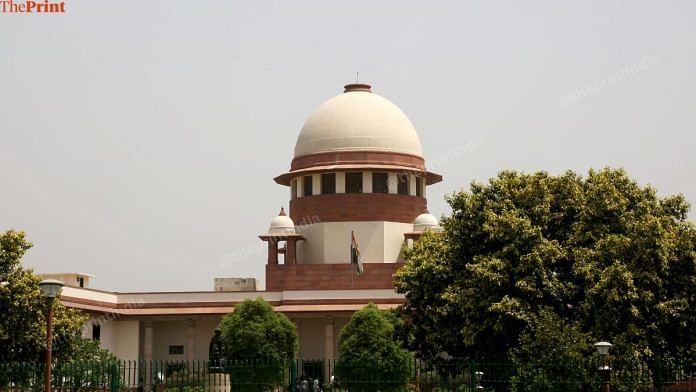Thank you dear subscribers, we are overwhelmed with your response.
Your Turn is a unique section from ThePrint featuring points of view from its subscribers. If you are a subscriber, have a point of view, please send it to us. If not, do subscribe here: https://theprint.in/subscribe/
In recent weeks, the Supreme Court’s vocal criticism of the Tamil Nadu Governor’s delay in assenting to state legislation has stirred robust debate. While judicial vigilance over constitutional norms is welcome, the tone, timing, and frequency of interventions raise an equally vital question: is the judiciary itself adhering to the bounds of its mandate?
The framers of our Constitution envisaged a delicate balance between the three organs of state—legislature, executive, and judiciary—each acting as a check and balance upon the others. But that balance begins to tilt dangerously when the Supreme Court appears to substitute its discretion for that of the executive or legislature, in effect stepping into the shoes of governance. The very idea of constitutionalism rests on institutional restraint, not judicial omnipotence.
In the Tamil Nadu case, the Supreme Court took the rare step of summoning the Governor’s legal representatives and implicitly directing timelines for action on pending bills. While the delay by the Governor warrants criticism, what is less acknowledged is the possibility that these bills—especially those impacting university governance—may have been passed in haste, motivated by political vendetta rather than policy vision. The Governor, as a constitutional conscience keeper, has a duty to ensure that bills he assents to conform to the spirit and letter of the Constitution.
Furthermore, the Supreme Court must remember that the President of India is the constitutional head of state, the final authority in legislative assent, and the person who administers the oath of office to Supreme Court judges.This is not ceremonial trivia—it is a constitutional reality. Judges are not sovereign unto themselves; their powers derive from the Constitution and are shaped by institutional design. The Court is not above the Constitution—it is one of its custodians.
Therefore, asserting judicial dominance over every aspect of governance risks damaging federal harmony, weakening the executive’s authority, and setting a precedent of judicial supremacy rather than constitutional balance.
But the deeper issue lies within the judiciary itself. The Supreme Court, while delivering sermons on constitutional delays, is sitting on a backlog of over 50,000 pending cases—a crisis that has persisted for decades. Thousands of appeals, many involving life and liberty, await final adjudication. Families await closure. Businesses await clarity. Policy hangs in limbo. Justice is delayed —whether the delay emanates from Raj Bhavan or Tilak Marg.
The irony is stark. While rebuking governors for inaction, the judiciary must ask itself why it has failed to deliver justice swiftly. Why do appeals linger for years? Why do constitution benches sit so infrequently? Why do key constitutional questions—from delimitation to personal liberty—gather dust for want of priority?
The time has come for serious introspection and structural overhaul. India cannot afford a Supreme Court that plays both final appellate authority and constitutional guardian—it is simply overwhelmed. No major democracy entrusts both functions to a single institution. Germany, South Africa, Italy, and Brazil all have separate constitutional courts and appellate tribunals. It is time India followed suit.
There is now a strong, urgent case for the creation of a “National Court of Appeal”—with benches across the country to handle routine civil, criminal, and administrative appeals. This court would act as a final appellate body below the Supreme Court. The Supreme Court, in turn, must be redefined as the “Constitutional Court of India,” concerned only with constitutional matters, federal disputes, and fundamental rights.
Such a reform would:
- Dramatically reduce pendency.
- Ensure constitutional focus.
- Allow for timely disposal of important legal questions.
- Improve access to justice across regions.
Simultaneously, internal timelines must be institutionalized within the judiciary. Much like how legislators are bound to respond within days during emergencies, the Supreme Court must adopt self-imposed deadlines for case disposal. Matters involving life and liberty should not remain unheard for years. Delays breed frustration, erode public trust, and delegitimize the institution in the eyes of the very citizens it serves.
Finally, judicial appointments and transparency must be improved. The collegium system continues to draw criticism for opacity. The Supreme Court cannot seek accountability from others without practicing it within.
India is not a judicial oligarchy. It is a constitutional republic. Courts exist to interpret laws, not to govern. Respecting the limits of institutional competence is not a weakness—it is democracy’s strength. As much as the executive must avoid legislative overreach, the judiciary must guard against assuming a moral veto over political decisions.
The Supreme Court is a vital pillar of Indian democracy. Its independence is sacrosanct. But with great power comes greater responsibility—and even greater restraint. It is time the Court heeded the lesson it so often quotes: the Constitution is supreme, not any institution.
Mohan Murti, FICA, Advocate & International Industry Arbitrator, Former Managing Director-Europe, Reliance Industries Ltsd. Germany
These pieces are being published as they have been received – they have not been edited/fact-checked by ThePrint.


